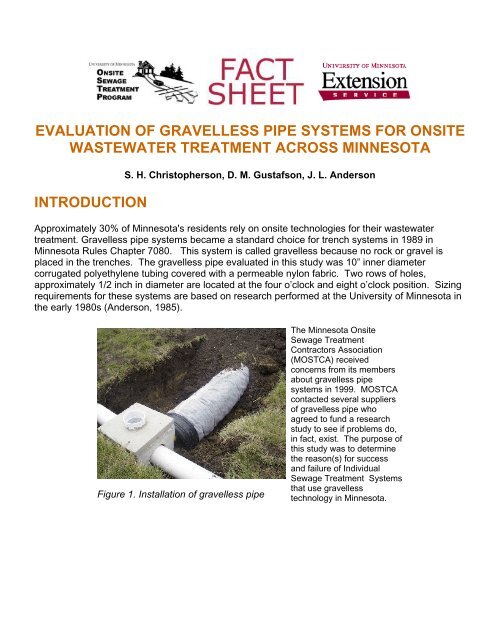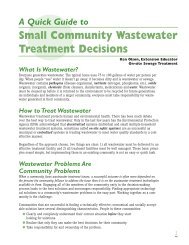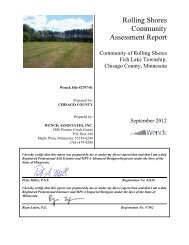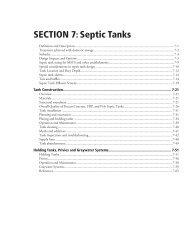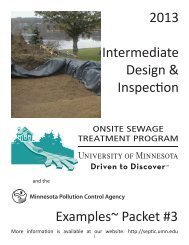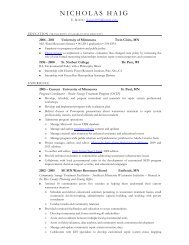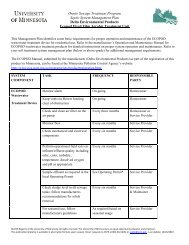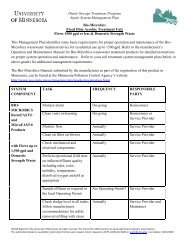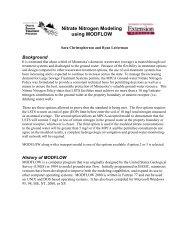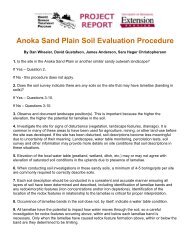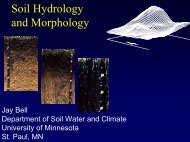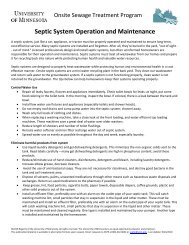evaluation of gravelless pipe systems for onsite wastewater
evaluation of gravelless pipe systems for onsite wastewater
evaluation of gravelless pipe systems for onsite wastewater
Create successful ePaper yourself
Turn your PDF publications into a flip-book with our unique Google optimized e-Paper software.
EVALUATION OF GRAVELLESS PIPE SYSTEMS FOR ONSITE<br />
WASTEWATER TREATMENT ACROSS MINNESOTA<br />
INTRODUCTION<br />
S. H. Christopherson, D. M. Gustafson, J. L. Anderson<br />
Approximately 30% <strong>of</strong> Minnesota's residents rely on <strong>onsite</strong> technologies <strong>for</strong> their <strong>wastewater</strong><br />
treatment. Gravelless <strong>pipe</strong> <strong>systems</strong> became a standard choice <strong>for</strong> trench <strong>systems</strong> in 1989 in<br />
Minnesota Rules Chapter 7080. This system is called <strong>gravelless</strong> because no rock or gravel is<br />
placed in the trenches. The <strong>gravelless</strong> <strong>pipe</strong> evaluated in this study was 10” inner diameter<br />
corrugated polyethylene tubing covered with a permeable nylon fabric. Two rows <strong>of</strong> holes,<br />
approximately 1/2 inch in diameter are located at the four o’clock and eight o’clock position. Sizing<br />
requirements <strong>for</strong> these <strong>systems</strong> are based on research per<strong>for</strong>med at the University <strong>of</strong> Minnesota in<br />
the early 1980s (Anderson, 1985).<br />
Figure 1. Installation <strong>of</strong> <strong>gravelless</strong> <strong>pipe</strong><br />
The Minnesota Onsite<br />
Sewage Treatment<br />
Contractors Association<br />
(MOSTCA) received<br />
concerns from its members<br />
about <strong>gravelless</strong> <strong>pipe</strong><br />
<strong>systems</strong> in 1999. MOSTCA<br />
contacted several suppliers<br />
<strong>of</strong> <strong>gravelless</strong> <strong>pipe</strong> who<br />
agreed to fund a research<br />
study to see if problems do,<br />
in fact, exist. The purpose <strong>of</strong><br />
this study was to determine<br />
the reason(s) <strong>for</strong> success<br />
and failure <strong>of</strong> Individual<br />
Sewage Treatment Systems<br />
that use <strong>gravelless</strong><br />
technology in Minnesota.
PROCEDURES<br />
Of the fourteen <strong>systems</strong> evaluated, eleven <strong>systems</strong> had experienced problems (surfacing to the<br />
ground and backups into home) while the remaining three did not exhibit any obvious signs <strong>of</strong><br />
failure. Typically, if the <strong>gravelless</strong> system exhibited functional problems, either the homeowner or a<br />
septic system pr<strong>of</strong>essional contacted the University <strong>for</strong> assistance to determine why there was a<br />
problem. A system usage survey was given to each homeowner. In<strong>for</strong>mation requested included:<br />
flow data (measured or estimated), number <strong>of</strong> people living in home, design (including size and<br />
location <strong>of</strong> septic tank and soil treatment system), age and per<strong>for</strong>mance <strong>of</strong> system, maintenance<br />
history and usage <strong>of</strong> garbage disposal, dishwasher, laundry, water s<strong>of</strong>tener, antibacterial soap and<br />
cleaning supplies. Individual locations had a detailed site analysis per<strong>for</strong>med to evaluate the soil,<br />
system, location and condition.<br />
The trenches were evaluated to determine the depth <strong>of</strong> ponding in each trench and amount <strong>of</strong><br />
biomat development. Soil borings were conducted to determine depth to water table or other<br />
limiting soil conditions. Soil samples were taken to determine soil texture classification from particle<br />
size analysis distribution analysis, (US Department <strong>of</strong> Agriculture, 1993).<br />
Effluent samples were collected from the septic tank and from inside the <strong>gravelless</strong> <strong>pipe</strong>. These<br />
were taken as grab samples. Samples were taken at the 40% liquid depth at the outlet <strong>of</strong> the<br />
septic tank and in the <strong>gravelless</strong> <strong>pipe</strong> with a Masterflex pump. Samples were analyzed <strong>for</strong><br />
dissolved oxygen (DO), biological oxygen demand (BOD), and total suspended solids (TSS). All<br />
samples were collected and analyzed in accordance with Standard Methods <strong>for</strong> Examination <strong>of</strong><br />
Water and Wastewater (American Public Health Association, 1992).
RESULTS AND DISCUSSION<br />
System locations are shown in Figure 2. The number in the county represents the number <strong>of</strong><br />
<strong>systems</strong> evaluated. The map illustrates that the study was concentrated in and around the<br />
northern metropolitan area and central Minnesota. These locations were selected based on<br />
homeowner and/or contractor requests. As a result, this provided a focus on problem areas and, in<br />
particular, sites with fine sand soil textures.<br />
Figure 2. Location <strong>of</strong> Gravelless Pipe Systems Evaluated.<br />
Soil texture was identified by the feel method at each site and followed up with a sieve analysis to<br />
confirm those field results. Table 1 summarizes the soil textures and number <strong>of</strong> <strong>systems</strong> evaluated<br />
with and without problems <strong>for</strong> each soil texture. Sieve results are included in the individual reports.
Soil<br />
Classification<br />
Results <strong>of</strong> Effluent Analyses<br />
Table 1. Soil Classification by System<br />
# <strong>of</strong> <strong>systems</strong><br />
with problems<br />
# <strong>of</strong> <strong>systems</strong> with<br />
no problems<br />
Sand 3 1<br />
Fine sand 5 2<br />
Loam 1 >NA<br />
Sandy clay<br />
loam<br />
1 NA<br />
Loamy sand 1 NA<br />
The results from the septic tanks and <strong>gravelless</strong> <strong>pipe</strong> <strong>for</strong> BOD, TSS and DO were all within normal<br />
levels to be expected in a septic tank effluent. The BOD values were all below 220 mg/1 and the<br />
TSS values were below 65 mg/1. Many <strong>of</strong> these were skewed because the first thing many<br />
homeowners do when there is a problem is to pump the septic tank. This pumping affects these<br />
results and the typical operation <strong>of</strong> these tanks may have been different. Visual inspection<br />
indicates that there is reason <strong>for</strong> concern that some <strong>of</strong> these tanks may not be watertight. This was<br />
not apparent during the site <strong>evaluation</strong>s but these were not done during the spring when such high<br />
water table conditions may exist, in the vicinity <strong>of</strong> the tanks.<br />
Flow Results<br />
Five <strong>of</strong> the eleven homeowners installed flow meters to monitor the flow. Flows were monitored <strong>for</strong><br />
periods <strong>of</strong> seven to fourteen days. Three <strong>of</strong> the homes had flows well below the design levels.<br />
Two were close to or above their design flow rates. It is not possible to make a definitive<br />
conclusion based on such limited time periods. However, consistent flows at or above design<br />
values will shorten the life and reduce per<strong>for</strong>mance in any <strong>onsite</strong> system.<br />
The other homes refused or could not install a flow meter. In these instances we do not know if the<br />
system is being hydraulically overloaded. Based on the number <strong>of</strong> people living in these homes<br />
and the number <strong>of</strong> water using devices, none <strong>of</strong> them appear to be exceeding the daily estimated<br />
sewage flow rates.
Homeowner Usage Results<br />
The table below summarizes some <strong>of</strong> the homeowner water use patterns.<br />
House Age Garage<br />
Disposal<br />
Table 2. Homeowner Data Summary<br />
Water<br />
S<strong>of</strong>tener<br />
Dish<br />
washer<br />
Anti-bacterial<br />
Soap<br />
Long Term<br />
Prescription<br />
Drug(s)<br />
Date <strong>of</strong> Last<br />
Pumping<br />
1 10 x x x x Summer<br />
1999<br />
2* 2 Spring 1999<br />
3 4 na na na na na na<br />
4 9 x x Summer<br />
2000<br />
5 4 x x x x Winter 1999<br />
6 5 x x Summer<br />
2000<br />
7 7 x x x Fall 98<br />
8 6 na na na na na<br />
9 5 x x Summer<br />
2000<br />
10 5 x x Summer<br />
2000<br />
11 10 na na na na na na<br />
12 5 x x Summer<br />
2000<br />
13* 3 x x x Spring 2000<br />
14* 7 x x x Fall 1999<br />
* Systems with no apparent problems<br />
Reasons <strong>for</strong> Failure<br />
The average age <strong>of</strong> the <strong>gravelless</strong> system evaluated was six years with a minimum age <strong>of</strong> two and<br />
the maximum <strong>of</strong> ten years. Age is important because Chapter 7080 became mandatory in 1996.<br />
Previously using 7080 was voluntary, so a person could choose to downsize <strong>gravelless</strong> <strong>systems</strong> by<br />
20-50%, which was a manufacturers recommendation.<br />
This <strong>evaluation</strong> looked at <strong>systems</strong> using various ‘brands’ <strong>of</strong> <strong>gravelless</strong> <strong>pipe</strong>. There are four main
suppliers <strong>of</strong> <strong>gravelless</strong> <strong>pipe</strong> in Minnesota. Problems were seen among all four brands. The<br />
products, particularly the fabric, vary by brand and year <strong>of</strong> installation.<br />
Hydraulic failure <strong>of</strong> an <strong>onsite</strong> system is <strong>of</strong>ten caused by either daily sewage flows exceeding the<br />
design rate, or an incorrect <strong>evaluation</strong> <strong>of</strong> the long-term acceptance rate. The long-term<br />
acceptance rate can be negatively affected by improper site ands soils <strong>evaluation</strong>, improper system<br />
location, improper construction practices and lack <strong>of</strong> maintenance (Anderson, 1982). One or more<br />
<strong>of</strong> these factors can result in system failure.<br />
All the <strong>systems</strong> evaluated with problems were either designed or installed improperly. Not one site<br />
with problems was designed according to Chapter 7080. At each site, all trenches were ponded<br />
with effluent. Four primary factors were identified that negatively affected the <strong>systems</strong>.<br />
1.<br />
2.<br />
3.<br />
Nine <strong>of</strong> the eleven problem <strong>systems</strong> evaluated were undersized according to design criteria.<br />
Of these nine, two were designed 50% too small, four - 40% too small, one - 30% too small<br />
and two - 20% too small. The table below from Chapter 7080.0170 indicates the required<br />
sizing factors. Two <strong>of</strong> these <strong>systems</strong> did not have three feet <strong>of</strong> separation as well. A<br />
common error was to size a fine sand as a coarse or medium sand or as a sandy loam. This<br />
general reduced size, combined with near design flows will limit the long-term per<strong>for</strong>mance <strong>of</strong><br />
these <strong>systems</strong>.For example, a system <strong>for</strong> a 3 bedroom is designed to treat 450 gallons per<br />
day. If a system is designed based on a medium sand texture it may, in fact, be large enough<br />
<strong>for</strong> 225 gallons per day flow if the soil texture is fine sand.<br />
Figure 3. Soil Characteristics and Sizing Factors According to Chapter 7080<br />
Three <strong>of</strong> the eleven were designed and installed with less than the required three-foot<br />
separation to the water table. Chapter 7080 requires three feet <strong>of</strong> unsaturated soil be<br />
present beneath the trench to adequately treat sewage. (See Chapter 7080.0060). At one site<br />
the standing water level was visible at the same depth as the <strong>gravelless</strong> <strong>pipe</strong>. At the other<br />
two, redoximorphic features (mottling) were used to determine the seasonally high water<br />
table. Two <strong>of</strong> these <strong>systems</strong> were undersized as well. One was 30% too small and the other<br />
was 40% too small.<br />
One <strong>of</strong> the <strong>systems</strong> was installed improperly. Trench <strong>systems</strong> must be installed level<br />
following land contours. (See Chapter 7080.0060). There was a four-inch drop from one end<br />
<strong>of</strong> the <strong>pipe</strong> to the other over the fifty-foot trench length. There<strong>for</strong>e as the sewage seeks its<br />
own level it will surface at the point <strong>of</strong> lowest elevation. This occurred at the far end, where<br />
the soil cover was lower than the elevation <strong>of</strong> the outlet from the distribution box.
4.<br />
All <strong>systems</strong> evaluated had biomat development, varying from one to four inches surrounding<br />
the <strong>pipe</strong>. When septic tank effluent is applied to soil, a biomat <strong>for</strong>ms at the interface <strong>of</strong> the<br />
soil and the <strong>gravelless</strong> <strong>pipe</strong>. Development <strong>of</strong> the biomat occurs more quickly under anaerobic<br />
conditions. There<strong>for</strong>e, separation distance to the water table is critical to provide an aerated<br />
soil below the biomat.<br />
Table 3. System Summary<br />
House Age Amount <strong>of</strong> Biomat<br />
(inches)<br />
Problem(s)<br />
1 10 3 Does not have 3 feet <strong>of</strong> separation<br />
40% too small<br />
2* 2
The biomat extends into the soil; there<strong>for</strong>e<br />
the fabric is not inhibiting biomat development<br />
in the soil (Anderson, 1982). When the<br />
biomat was removed from around the <strong>pipe</strong><br />
the effluent would run out <strong>of</strong> the <strong>pipe</strong>. This is<br />
a normal function, it is why effluent ponds in<br />
any sewage treatment trench. This indicates<br />
that the effluent was being prevented from<br />
leaving the <strong>gravelless</strong> <strong>pipe</strong> by the biomat.<br />
There is the possibility that the <strong>pipe</strong> could be<br />
plugged from the inside as well, but this was<br />
not apparent at any <strong>of</strong> the sites evaluated in<br />
this study. There was no apparent<br />
accumulation <strong>of</strong> sludge or other material in<br />
the <strong>pipe</strong>.<br />
All three <strong>systems</strong> that did not have three feet <strong>of</strong> separation (two <strong>of</strong> which were downsized as<br />
well) had 3 inches <strong>of</strong> biomat surrounding the <strong>pipe</strong>. All <strong>of</strong> <strong>systems</strong> that were sized 30-50% too small<br />
had 2-4 inches <strong>of</strong> biomat surround the <strong>pipe</strong>. These values indicate the <strong>systems</strong> are probably<br />
hydraulically overloaded.<br />
Reasons <strong>for</strong> Success<br />
1. Two <strong>of</strong> three <strong>systems</strong> visited had two septic tanks. This is above what Chapter 7080<br />
requires. It provides additional settling time and storage space.<br />
2. All three <strong>systems</strong> were sized appropriately based on estimated daily sewage flow and soil.<br />
3. All three <strong>systems</strong> had three feet or more <strong>of</strong> vertical separation to the water table.<br />
4. On average, only half <strong>of</strong> the trenches had effluent ponded in the <strong>pipe</strong>.<br />
CONCLUSIONS<br />
1. The sample size was too small to provide definitive answers about whether <strong>gravelless</strong> <strong>pipe</strong><br />
has problems.<br />
2. All <strong>of</strong> the <strong>systems</strong> in this study evaluated had design or construction errors. These errors<br />
strongly contributed to the failure <strong>of</strong> the <strong>systems</strong> evaluated. These errors may be due to lack<br />
<strong>of</strong> knowledge by designer/installer and local unit <strong>of</strong> government staff, pricing/bidding issues or<br />
simply a mistake.<br />
3.<br />
The sites we evaluated appeared to be plugging from the outside <strong>of</strong> the <strong>pipe</strong> due to biomat<br />
development that would indicate that the problem is not due to the product itself, but how it is<br />
sized and installed.
RECOMMENDATIONS<br />
1. More <strong>systems</strong> should be evaluated to determine if there is a problem with <strong>gravelless</strong> <strong>pipe</strong>.<br />
2. If there is doubt about how a soil should be sized the larger soil-sizing factor should be<br />
chosen.<br />
3. Sieve analysis should be done with sandy soils that appear to have large amounts <strong>of</strong> fines.<br />
4. A technique to accurately judge the amount <strong>of</strong> buildup on the fabric material should be<br />
developed. Tests that have been done are unable to differentiate between plugging on the<br />
inside or outside and soil particles that remain attached to the media.<br />
ACKNOWLEDGEMENTS<br />
The Minnesota Onsite Sewage Treatment Contractors Association (MOSTCA) funded this<br />
project. Thanks to the homeowners, contractors and local units <strong>of</strong> government that<br />
assisted.<br />
For more in<strong>for</strong>mation about the individual sites evaluated please call (612) 625-7243 or email<br />
heger001@umn.edu<br />
REFERENCES<br />
American Public Health Association. 1992. Standard Methods <strong>for</strong> Examination <strong>of</strong> Water and<br />
Wastewater (18 th 1.<br />
edition). American Public Health Association, Washington D.C.<br />
2.<br />
3.<br />
4.<br />
5.<br />
Anderson, J. L., R. E. Machmeier and M. P. Gaffron. 1985. Evaluation and Per<strong>for</strong>mance <strong>of</strong><br />
Nylon Wrapped Corrugated Tubing in Minnesota. Proceedings <strong>of</strong> the Forth National<br />
Symposium on Individual and Small Community Sewage Systems. American Society <strong>of</strong><br />
Agricultural Engineers, St. Joseph, MI.<br />
Anderson, J. L., R. E. Machmeier and M. J. Hansel. 1982. Long-Term Acceptance Rates <strong>of</strong><br />
Soils For Wastewater. Proceedings <strong>of</strong> the Third National Symposium on Individual and Small<br />
Community Sewage Systems. American Society <strong>of</strong> Agricultural Engineers, St. Joseph, MI.<br />
Minnesota Pollution Control Agency. 1999a. Minnesota rules chapter 7080 – individual<br />
sewage treatment <strong>systems</strong> program. Office <strong>of</strong> Reviser <strong>of</strong> Statutes, St. Paul, MN.<br />
United States Department <strong>of</strong> Agriculture. 1993. Soil Survey Manual. US Government<br />
Printing Office, Washington, DC.


